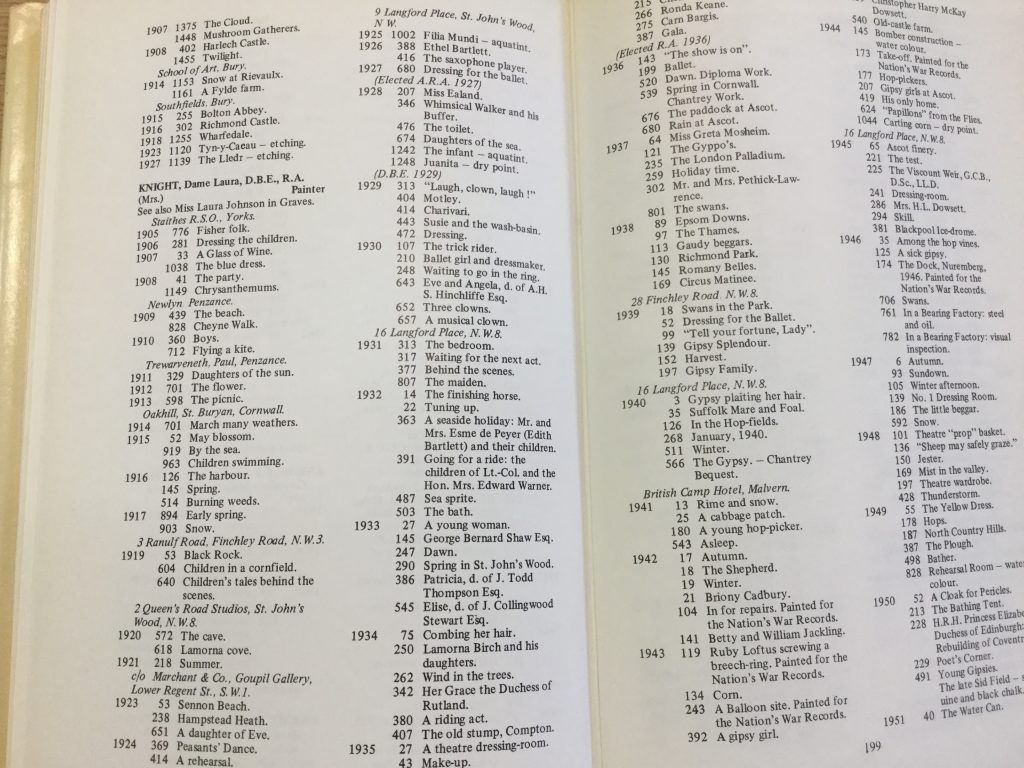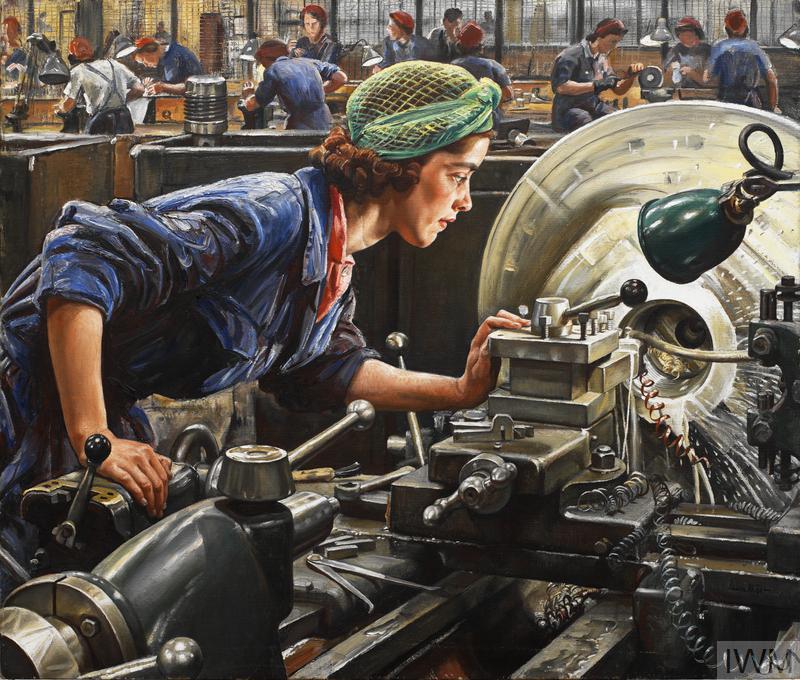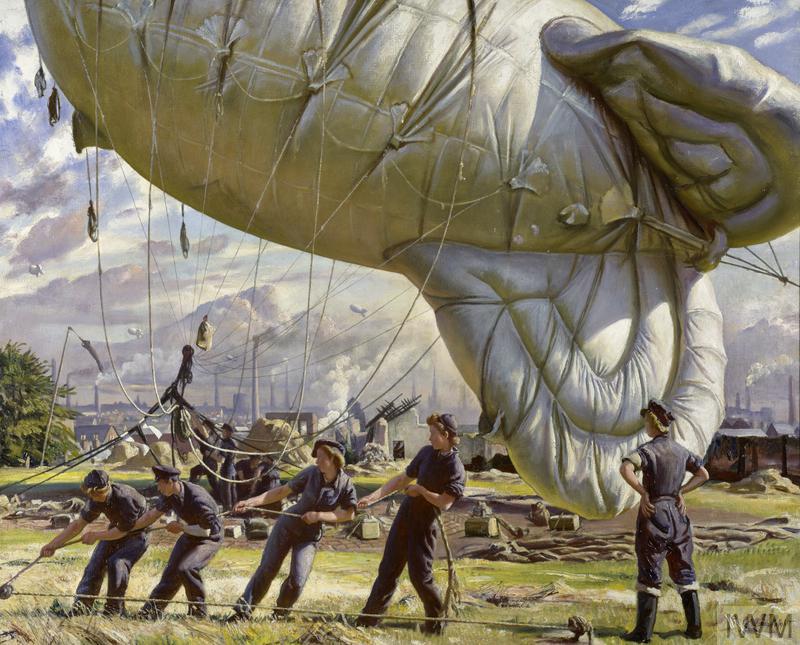Artists at war: Dame Laura Knight
Introduction
During her lifetime Dame Laura Knight was one of the most successful and popular British artists. She was a household name but, after her death in 1970, she slowly became forgotten and her work overlooked. This is in part as her work was founded on realism and naturalism and did not fit into the late C20th art world where abstraction and experimentation were viewed more favourably than naturalism. It is only in recent years* that her work has become well-known again.
Royal Academy of Arts
In recognition of her artistic achievements she was created a Dame in 1927. In 1936 she was the first woman to be elected to the Royal Academy of Arts. She exhibited her first work at the Royal Academy Summer Exhibition in 1903. The painting, entitled Mother and Child, was exhibited under her maiden name of Johnson. Between 1903 and 1935 there were only a couple of years when she did not have a painting accepted. After she became an Academician she usually exhibited the allotted 6 piece of work that members were allowed.

Character and Personality
She worked very hard and her output was prolific including prints as well as paintings and drawings. She was commercially successful and made a living from her work. Her subjects were diverse. They ranged from Cornish landscapes, Yorkshire fisherman to circus performer, actors and actresses. In 1919 she was allowed to work backstage at the Coliseum where Diaghilev’s Ballet Russes were performing.
Knight was very sociable and she had a gift for friendship and a great interest in people. She befriended her subjects, and in the case of the travellers and Romany gypsies she even travelled and lived with them. Not only was she interested in her subjects but also in their whole way of life and their communities and she had a particular interest in people on the margins of conventional society. Not for Knight was the painting of society portraits, though she did accept commissions for a few. She preferred to depict ordinary domestic scenes and to show people’s working lives in all different guises from fishermen to dancers and actors. Her humanity, love of people and interest in their lives shines out of her paintings. This combined with her lively, naturalistic depiction is what made and continues to make her work popular.
Her flamboyancy and forthrightness, and her perceived eccentricity, meant that she provided good copy for newspaper editors. For example, when she painted scenes of the Epsom races from a Rolls Royce. Photos of her show her in folksy embroidered blouses with her hair wound in plaits above her ears.
Early Life and Career as an Artist
Knight was born in 1877 in Long Eaton in Derbyshire. Her mother, an art teacher, came from a middle class family who owned a lace-making factory. While pregnant with Laura she left her husband and returned to her family home with Laura’s two sisters. So, she grew up in a mainly matriarchal household with her mother, sisters, grandmother, great-grandmother and uncle. She drew from a very early age and her artistic talent was evident and she enrolled at Nottingham School of Art aged 14. In 1903 she married a fellow pupil, Harold Knight who was three years her senior, and the two began to pursue their artistic professional lives. They joined established artistic communities, first in Staithes in Yorkshire and in 1907 they moved to Cornwall and joined the artistic community around the fishing village of Newlyn.
She painted en plein air and her work, especially the work in Cornwall, captures the feeling of light, sun and wind. She didn’t experiment and wanted to paint what she saw as realistically as she could. Her hard work led to early success and her large-scale painting of children on a beach (The Beach 1908) met with praise when it was exhibited at the Royal Academy.
First World War
During the war Harold Knight was a conscientious objector, and worked on the land, while Laura carried on with her own work.
She was commissioned by Canadian War Memorials** to to paint Canadian troops who were stationed in Britain prior to being sent to the Western Front. In November 1916 she went to Witley Camp in Surrey where the 156th Canadian Infantry Battalion were stationed. The original idea for the commission was for a 14 foot long painting of the soldiers bathing in the river (this seems rather odd but this is what her autobiography says) but being November the river was muddy and no bathing was taking place. While there Knight spotted a boxer, Joe Shears who was the then Imperial Forces bantam weight champion, and was immediately taken with his face, damaged by boxing, and his cauliflower ears. The resulting painting was called Physical Training at Whitley Camp and shows two boxers in an open-air ring with the Surrey hills in the background
Second World War
Knight was one of the many artist who were given short-term contracts by WACC* but she was one of the few women artists. Her most famous painting is the rather inelegantly titled “Ruby Loftus Screwing a Breech Ring”. This was commissioned in October 1942 to encourage women to come and work in the factories for the war effort at a time when retention of women and absenteeism were issues, owing to inadequate childcare and long hours, and factories were seen as unpleasant places to work.

Ruby Loftus, 21, was employed at the Royal Ordnance Factory in Monmouth. She had moved with her her family after they were bombed out of Golders Green and she had previously been a tobacconist’s assistant. Ruby was chosen as a subject as she had very quickly mastered a very delicate engineering process of preparing the breech ring component of a Bofors breech gun- an antiaircraft/multi-purpose autocannon. This process was described as one that could take men of exceptional ability eight or nine years to master.
Other Work for WAAC
Knight also painted three portraits of of WAAFs who had been awarded were military medals. Other war paintings included factory workers involved in making items for the war effort. Another painting that shows Knight’s skill was of a barrage balloon being hoisted into position by WAAF women in blue overalls with Coventry visible in the background.

She spent time at RAF Mildenhall painting the moment when a plane takes off-from the interior of the plane-described by the RAF men as one of the most frightening moments of a flight, the next being when their target was in sight. There is a photo of her painting a clown emblem on one of their planes.
War poster
In 1944 Knight designed a poster warning against the danger of fires in factories-fires destroyed several factories that were engaged in the war effort. These were distributed to every workshop in the country and she did the work for free. She spent time at the Austin works at Longbridge making sketches for the poster. Longbridge was where the Stirling bomber was being produced and her stay inspired her to paint a huge watercolour, painted on sheets of watercolour paper mounted on board. It was shown at the RA Summer Show in 1944.
In her autobiography she barely mentions the war. She describes her work for the WAAC as “employed picturing the making of instruments to kill… But one wants to forget”.
Nuremberg Trials
Once the war was over Knight embarked on what must have been her most harrowing of commissions when she was sent to pictorially record the Nuremburg trials. On 5th January 1946 she was flown to Germany where she was shocked by the devastation she saw and by the poverty and hunger of the people. This was in stark contrast to the comfortable accommodation that Knight was staying in and and the rich food she dined on which was bought in by air from the USA. Hearing at first hand the accounts of the wartime atrocities cannot have been easy especially for someone of Knight’s humanity. She returned to England at the end of April 1946.
Knight made numerous sketches at the trial and once back in England she began to work on her painting of the trial. The painting marks a departure for Knight as in the upper part of the painting the court room, which is full of defendents, lawyers and military police, gives ways to scenes of bombing and wartime destruction.

Once again Laura Knight is receiving the recognition that she deserves. Her humanity and skill make her war time paintings some of the most vivid and compelling of any war artist.
[Fiona, Library Assistant]
*Partly due to the 1989 TV series Five Women Painters which bought her work back into the public awareness. The other four painters were: Dora Carrington, Nina Hammett, Winifred Nicholson and Eileen Agar.
** See Artists at War: Paul Nash and the First World War for further information about this scheme.
Bibliography
Dame Laura Knight
Five Women Painters
Laura Knight in the Open Air
Laura Knight Portraits
The Magic of Line: an Autobiography of Laura Knight
The Night Raid
The Royal Academy of Arts: A Complete Dictionary of Contributors and Their Work from its Foundation in 1797 to 1904
Royal Academy Exhibitors 1905-1970
War Paint: Art, War State and Identity in Britain 1939-1945
Images sources
- Royal Academy Exhibitors 1905-1970 , volume IV, page 198
- Ruby Loftus screwing a Breech-ring © IWM (Art.IWM ART LD 2850)
- A Balloon Site, Coventry © IWM(Art.IWM ART LD 2750)
- The Nuremberg Trial, 1946 © IWM (Art.IWM ART LD 5798)
Related links and source material
The Beach
Diaghilev London Walk
Official Dame Laura Knight website
Physical Training at Whitley Camp
Sawdust and Sequins: The Art of the Circus 2018 marks the 250 anniversary of the modern circus. This exhibition features Dame Laura Knight’s paintings of circuses alongside work by other artists.
Library members can access the entries in the Oxford Dictionary of National Biography and Oxford Art Online for the people listed above by clicking on the hyperlinks in the text.
We have created a Pinterest board where you can see further examples of Dame Laura Knight’s work.
